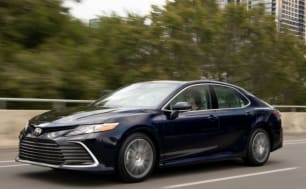As one of Australia's most popular mid-size SUVs, you'd hope the CX-5 is up to family duties, and the good news is it mostly aces the brief.
Up front, there's plenty of room for adults, with a good amount of adjustability, and great visibility despite a relatively high belt-line and dash.
The seats in this Touring Active grade are manual adjust only, which may be a downside for some, while the blended seat trim of ‘Maztex' synthetic leather and suede isn't my preference.
I'm more in favour of a basic cloth seat, which will be much easier to clean and will probably wear better, or the lovely real leather seats which appear on higher grades.
Nicely-sized bottle holders appear in the doors and centre console, and the latest update also brings a wireless charger under the climate unit, to match the wireless phone mirroring.
On the topic of phone mirroring, Mazda has taken the commitment to dial-operated systems to a fault.
The multimedia screen, perched atop the dash, is not a touch unit, and is instead operated only with the centre dial.
This dial is fine for operating Mazda's relatively straightforward software, but is downright clumsy when it comes to flicking through menus on Apple CarPlay, in particular.
Still, I appreciate the very straightforward climate panel, which consists of physical buttons and dials for all of its controls. Far preferable to the trendy touch panel, or worse, multimedia-screen interfaces on some rivals.
The rear doors open nice and wide, making it easy to fit child seats, and room back there is more than sufficient for adults in the outer two rear seats, as well.
I had plenty of legroom and headroom behind my own driving position at 182cm tall.
The quality trims continue in the doors, and there's a large bottle holder in each one, alongside a further two in the drop-down armrest.
Interestingly, this part also has a flip-open tray with two USB 2.0 connectors, a tidy way to get power to the rear passengers, but one which can't be used if the middle seat is occupied.
There are no additional outlets on the back of the centre console, although there is a set of air vents back there.
The boot measures in at 438 litres, which is not on the larger end for the mid-size SUV space, and may cause some families to run into issues, particularly if they need to carry a pram on top of regular luggage.
As it is though, it fit our CarsGuide demo luggage set with minimal room to spare. There is a space-saver spare wheel under the floor.






